Abstract
The synergistic effect of binary CdTiO2 and ternary NiCdTiO2 on the photocatalytic efficiency of TiO2 nanoparticles was investigated. The SEM analysis demonstrates spherical TiO2 NPs of different sizes present in agglomerated form. The structural analysis of the nanocomposites reveals a porous structure for TiO2 with well deposited Cd and Ni NPs. TEM images show NiCdTiO2 nanocomposites as highly crystalline particles having spherical and cubical geometry with an average particle size of 20 nm. The EDX and XRD analysis confirm the purity and anatase phase of TiO2, respectively. Physical features of NiCdTiO2 nanocomposite were determined via BET analysis which shows that the surface area, pore size and pore volume are 61.2 m2/g, 10.6 nm and 0.1 cm3/g, respectively. The absorbance wavelengths of the CdTiO2 and NiCdTiO2 nanocomposites have shown red shift as compared to the neat TiO2 due to coupling with Ni and Cd that results in the enhanced photocatalytic activity. The photocatalytic activity demonstrated that TiO2, CdTiO2 and NiCdTiO2 degrade methylene blue (MB) and methyl green (MG) about 76.59, 82, 86% and 63.5, 88, 97.5%, respectively, at optimum reaction conditions.
1. Introduction
Industrial effluents containing synthetic dyes is a formidable challenge for water remedy processes [1,2]. Dyes are used for the coloration of several materials such as textile fibers, cosmetics, paper, tannery, food, leather and pharmaceutical products [3]. These synthetic dyes are major water pollutants and cause serious environmental problems due to their high aromaticity, low biodegradability, toxicity, chemical stability and carcinogenic nature [4]. These dyes also reduce the light penetration which reduces the photosynthetic activity that causes a deficiency in dissolved O2 content of the water [5]. Various approaches are applied for the remediation of these pollutants such as adsorption [6], nanofiltration [7], ozonation [8], coagulation [9], biodegradation [10] and phytoremediation [11] etc. These conventional approaches are expensive, destructive, difficult and transform pollutants into sludge [12].
Advanced Oxidation Processes (AOPs) generate and use powerful transitory species such as hydroxyl radicals [13] to eliminate the organic pollutants by final conversion into small and stable molecules such as H2O and CO2 [14]. Among the AOPs, photocatalytic degradation is believed to be the most appropriate low-cost approach to treat organic pollutants [15]. Photodegradation has advantages over other conventional approaches owing to its simplicity, complete pollutants mineralization, cost-effectiveness, no harmful byproducts formation, ambient pressure and temperature operation [16]. Various semiconducting photocatalysts are used for the photodegradation of dyes such as ZnO [17], Fe3O4 [12], SnO2 [18], TiO2 [19] etc. Among these photocatalysts, titanium (IV) oxide has been the most investigated material for the environmental photocatalysis owing to its abundance, high specific surface area, nontoxicity, photostability, strong oxidation capability, low price, high photoactivity and chemical stability [20,21,22]. Titanium dioxide (TiO2) as an intrinsically n-type semiconductor material with a band gap of around 3 eV [23,24] is extensively suggested for diverse applications such as lithium-ion batteries [25], super-capacitors [26], solar cells [27], sensors [28] and photocatalysts [29,30,31]. However, TiO2 as photocatalyst represents low photocatalytic activity due to its high electron–hole pair recombination rate, wide band gap and its excitation only under UV light [32]. In order to retard these deficiencies, various approaches are developed such as doping [33], sensitization [34], supporting on a medium [35] and coupling with semiconductors [36,37,38]. Among these, coupling of TiO2 with other semiconducting material having lower band gap energy forming a heterojunction is a strategic option. The semiconductor having lower gap energy plays the role of sensitizer by being excited first, and then inducing the excitation of TiO2 by passing photoelectrons from its conduction band to that of TiO2 [39].
In the present work, TiO2 nanoparticles were prepared by precipitation technique and then coupled with Cd and Ni to obtain CdTiO2 and NiCdTiO2 nanocomposites through co-precipitation method. The CdTiO2 and NiCdTiO2 nanocomposites are not reported in literature nor utilized as photocatalysts in the photodegradation of dyes to the best of our knowledge. These photocatalysts were prepared from economical materials and simple approach. The photocatalysts are very efficient toward the photodegradation of both dyes. The photocatalytic efficacy of the TiO2, CdTiO2 and NiCdTiO2 was assessed by degradation of methylene blue (MB) and methyl green (MG) dyes in aqueous solution under UV-light irradiation. MB and MG are selected as model dyes because these are recalcitrant organic pollutants with carcinogenic and mutagenic nature with LD50 = 1180 mg/kg [40]. At higher concentration these dyes cause great damage to the human body and environment [41,42]. In the photodegradation of MB and MG dyes, the effect of irradiation time, catalyst dosage and pH were assessed.
2. Results and Discussion
2.1. Morphological and Elemental Analysis
The surface morphology of TiO2, CdTiO2 and NiCdTiO2 was studied via SEM analysis and the images at different magnifications are shown in Figure 1, Figure 2 and Figure 3, respectively. The images show spherical TiO2 NPs of different shapes and sizes and present mostly in agglomerated form. The particles are also present and dispersed when highly magnified. The SEM analysis of CdTiO2 shows that Cd NPs are deposited on the surface and embedded in the porous structure of TiO2. The morphology of CdTiO2 displayed that TiO2 are present in porous nanotubes form and Cd NPs are dispersed on its surface, and inserted in the nanochannels. The CdNiTiO2 nanocomposites are mostly agglomerated, and the Cd and Ni NPs significantly cover the pores and surface of TiO2. The particles have different shapes and morphology.
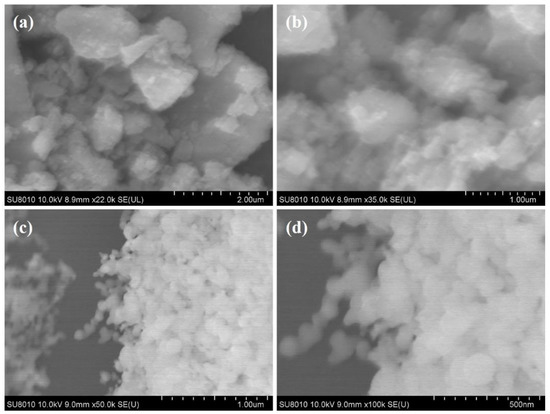
Figure 1.
(a–d) SEM images of TiO2 nanoparticles.
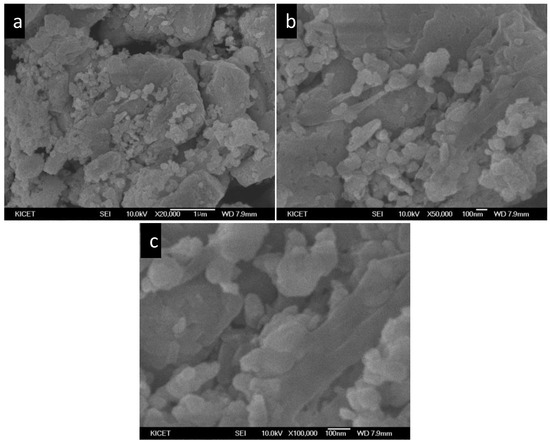
Figure 2.
(a–c) SEM images of CdTiO2 nanocomposite.
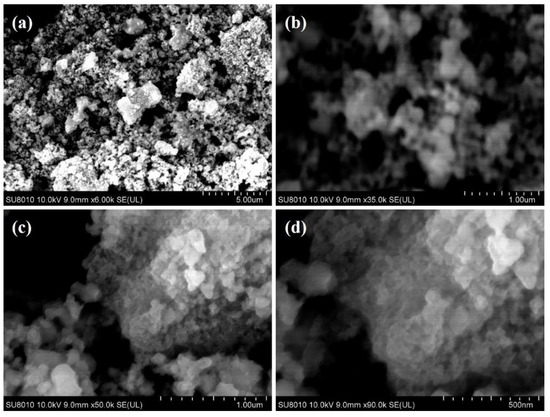
Figure 3.
(a–d) SEM images of NiCdTiO2 nanocomposite.
The ternary NiCdTiO2 nanocomposites were also examined via TEM analysis and the results are as shown in Figure 4 at different magnifications which support the SEM analysis. Images shows that Cd and Ni NPs are uniformly mixed with TiO2 NPs. Highly crystalline NiCdTiO2 nanocomposites of cubical as well as spherical geometry with an average particle size of 20 nm are confirmed by TEM images.
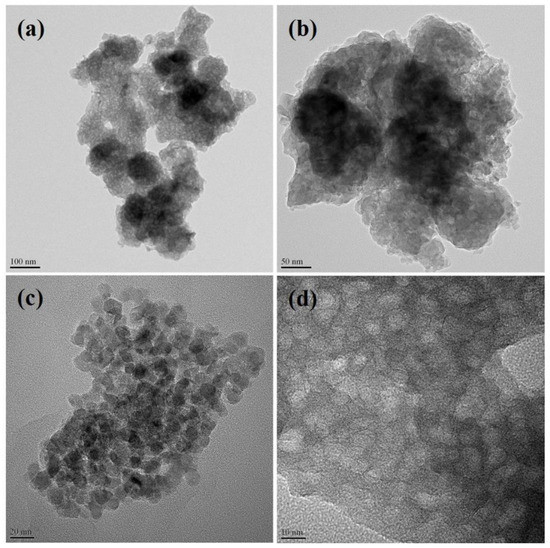
Figure 4.
(a–d) TEM images of NiCdTiO2 nanocomposite at different magnifications.
The composition of the ternary NiCdTiO2 nanocomposite was ascertained via EDX and the spectrum along with %composition in tabulated form is presented in Figure 5. The EDX spectrum shows signals for the constituent elements (Ti, Ni, Cd and O). The carbon and silver signals are present due to their coating on samples prior to EDX analysis for obtaining good quality images.

Figure 5.
(a) EDX spectra and (b) mapping of the ternary NiCdTiO2 nanocomposite.
2.2. XRD Analysis
The XRD patterns of the photocatalysts are displayed in Figure 6. The observed signals can be related to the corresponding (101), (004), (200), (105), (211), (204) and (116) crystal planes. The identified diffraction signals can be allocated to the anatase TiO2 (JCPDS-21-1272). Peaks for the Cd and Ni NPs are not observed owing to their minute quantity. However, (105) and (211) crystal plane peaks observed in the TiO2 patterns are replaced by single broadened peaks in the CdTiO2 and NiCdTiO2 nanocomposites patterns.
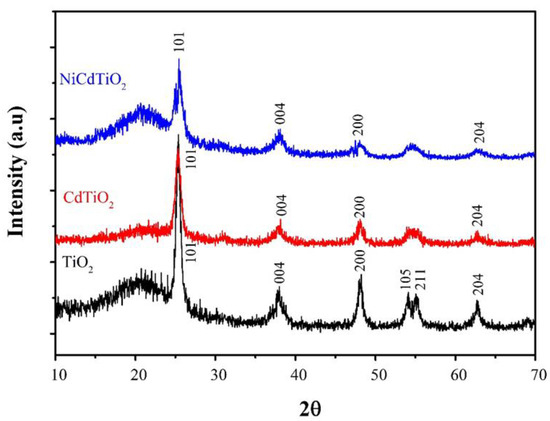
Figure 6.
XRD patterns of the TiO2, CdTiO2 and NiCdTiO2.
2.3. BET Analysis
The optimum porosity and high specific surface area are considered as essential parameters for the efficiency of nanocomposite materials used in photocatalysis. Figure 7a presents the BET and adsorption-desorption plot for NiCdTiO2 nanocomposite. The adsorption/desorption of N2 is important for investigating the surface area, average pore size and pore volume of the NiCdTiO2 photocatalyst. The study revealed that the NiCdTiO2 nanocomposite exhibit type IV isotherm with a sharp increase of the adsorbed volume starting from P/P0 = 0.84, confirming the mesoporous nanosized nature of the nanocomposite. When the relative pressure approaches 1, the hysteresis loop shifts higher and shows that the microporous particles are also present. Figure 7b shows BJH plot for the porosity investigation of NiCdTiO2 nanocomposite. Different surface parameters like BET surface area, pore size, volume and BJH average pore width of NiCdTiO2 nanocomposite are represented in the Table 1.
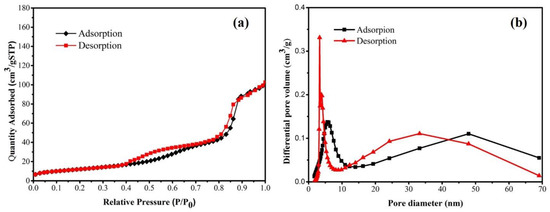
Figure 7.
(a) BET and adsorption desorption plot for NiCdTiO2 (b) BJH plot showing porosity evaluation of NiCdTiO2.

Table 1.
The specific surface area, pore size, pore volume and BJH average pore width of NiCdTiO2 nanocomposite.
2.4. UV-Visible Analysis
The absorbance wavelength and band gap energy of the TiO2, CdTiO2 and NiCdTiO2 were recorded using UV–VIS spectroscopy. Figure 8 displays the UV–VIS absorption spectra of TiO2, CdTiO2 and NiCdTiO2. The UV–Visible absorption spectrum of TiO2 shows absorption band at 265 nm. The maximum absorbance wavelengths of the CdTiO2 and NiCdTiO2 have shown slight red shifts. This shift can make nanocomposites better photocatalysts compared to pure TiO2.
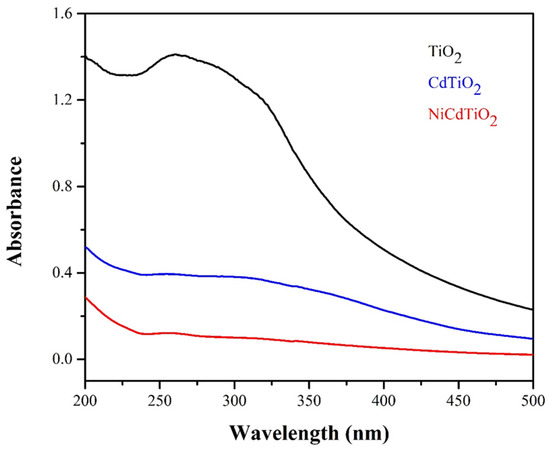
Figure 8.
UV–VIS absorption spectra of TiO2, CdTiO2 and NiCdTiO2.
Figure 9a–c displays the Tauc plots: (αhv)2 versus energy of TiO2, CdTiO2 and NiCdTiO2, respectively. The band gap was calculated applying Tauc plots, which represents the relation between the sample absorption edge with the energy of the incident photon.
where α = molar extinction coefficient, h = Planck constant, v = photon’s frequency, A = constant, Eg = band gap energy, and n = parameter associated with the electronic transition (½ in the present case). The results demonstrate 2.7 eV band gap energy for TiO2. The band gap energy values for CdTiO2 and NiCdTiO2 are 2.64 eV and 2.52 eV, respectively, as shown in the Figure 9c inset. The results clearly show the effect of Cd doping and Ni, Cd co-doping on the band gap energy of TiO2 which can further be correlated with the photocatalytic activity of the catalysts.
αhv = A(hv − Eg) n
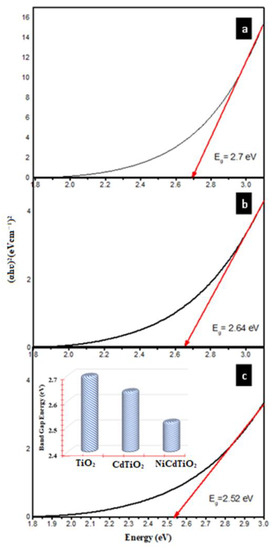
Figure 9.
Tauc plots: (αhv)2 versus energy for the (a) TiO2 (b) CdTiO2 (c) NiCdTiO2, inset; comparison of band gap energy.
2.5. Photodegradation of Methylene Blue (MB) Dye
2.5.1. Effect of Irradiation Time
The photocatalysts were utilized for the photodegradation of MB dye in aqueous medium under UV–light irradiation. Figure 10a–c displays the UV–VIS spectra of MB dye before reaction and after varying UV light-irradiation times in the presence of TiO2, CdTiO2 and NiCdTiO2, respectively. The MB dye has shown maximum absorbance in the absence of catalysts. A sharp decrease in the absorbance was observed in the presence of catalysts due to photodegradation of the dye. The absorbance shows a regular decrease in the presence of catalysts with increasing irradiation time. The %degradation of MB dye by the synthesized catalysts as presented in Figure 10d shows higher photocatalytic activity for the ternary NiCdTiO2 as compared to the binary CdTiO2 and neat TiO2. A 40, 48 and 65% degradation of the dye was observed within 20 min irradiation time with TiO2, CdTiO2 and CdNiTiO2, respectively. The degradation was increased to 76.59, 82 and 86% in the presence of TiO2, CdTiO2 and CdNiTiO2, respectively, by increasing irradiation time to 100 min. The increase in photodegradation of dye with an increase in irradiation time is due to the availability of more and more time to generate more hydroxyl radicals, which is a key species in dye degradation. The photocatalytic degradation experiments of MB using 30 ppm initial concentration were carried out under optimal reaction conditions and a pseudo first-order kinetics was observed. The results were in good agreement with the reported literature [42,43,44,45,46,47,48,49,50].
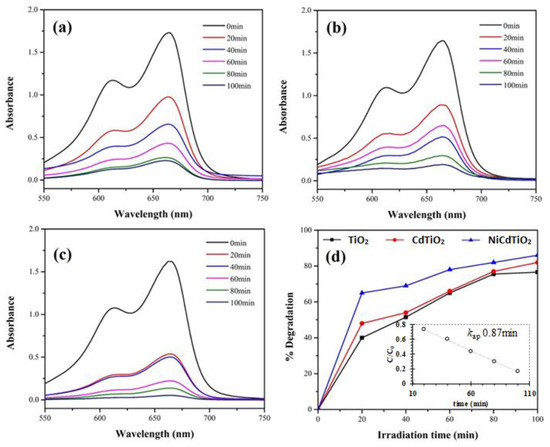
Figure 10.
UV–Visible absorption spectra of MB photodegraded by (a) TiO2 (b) CdTiO2 (c) NiCdTiO2 (d) Comparison of %degradation of MB dye inset kinetic model of degradation.
The photocatalytic degradation of dye depends upon the light-harvesting efficiency, the efficiency of the reaction of the photogenerated electron/hole charges and the reaction of photogenerated charges with substrate molecules. Photodegradation of the dye is achieved when UV-light interacts with the photocatalyst. Photons having energy equal to or greater than the band gap of the catalyst, excite the electrons from their valence band (VB) to the conduction band (CB) and produce positive holes (h+) in the VB. The h+ of the VB react with the water molecules and produce hydroxyl radicals (·OH) while the excited electrons present in the CB react with oxygen molecules and generate superoxide anion radicals (O2·−) [43,44]. These radicals are highly reactive species and effectively degrade dye molecules into simple and small species such as H2O and CO2. In the case of pristine TiO2, a major portion of the separated electron–hole pairs recombine and reduces the photocatalytic activity. However, in CdTiO2 and NiCdTiO2 nanocomposites, the electrons present in the VB of TiO2 get captured by the coupled Cd and Ni so the electron–hole pairs recombination rate decreases. This makes the nanocomposites more efficient photocatalysts compared to the neat TiO2. The suggested mechanism for the photodegradation of MB dye by ternary NiCdTiO2 nanocomposite is presented in Figure 11.
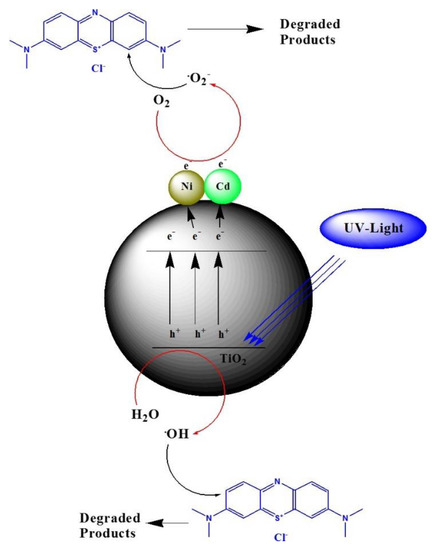
Figure 11.
Proposed mechanism of photodegradation of MB dye by NiCdTiO2.
2.5.2. Effect of Photocatalyst Dosage
As photocatalytic activity is greatly affected by the available active sites, the effect of catalyst dosage on the dye degradation was, therefore, also investigated. Different amounts of catalysts (0.010, 015, 0.020, 0.025 and 0.030 g) were taken with a fixed irradiation time (30 min) and dye amount (10 mL) and the results for the degradation process as monitored by UV-Vis spectroscopy are shown in Figure 12a–c for TiO2, CdTiO2 and NiCdTiO2 NPs, respectively. The %degradation of MB dye by TiO2, CdTiO2 and NiCdTiO2 is compared in the Figure 12d. With an increase in catalyst dosage, the %photodegradation was also increased. Maximum photodegradation was achieved with 0.030 g of the catalyst. With this amount, 76.5, 83.5 and 86% dye was degraded by TiO2, CdTiO2 and NiCdTiO2, respectively. Further increases in catalyst dosage beyond the limit (0.030 g) had no significance on the enhancement of the photocatalytic activity for the degradation process. No further increase in the catalytic activity could be attributed to the agglomeration of photocatalysts beyond the optimum dosage [16].
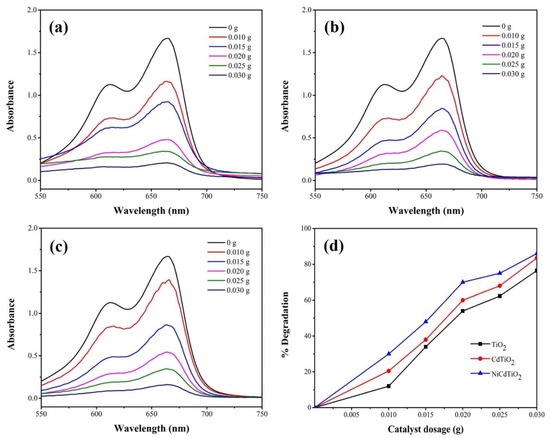
Figure 12.
UV-VIS absorption spectra of MB dye before and after different dosage of (a) TiO2 (b) CdTiO2 (c) NiCdTiO2 (d) Comparison of %degradation of MB dye photodegraded by different dosage of photocatalysts.
2.5.3. Effect of pH of the Medium
pH has an important role in the production of hydroxyl radicals responsible for the photodegradation process. Therefore, the effect of pH variation (2, 4, 6, 8, and 10) for a constant photocatalyst dosage (0.02 g) and irradiation time (30 min) on the photodegradation process was investigated and the results are shown in Figure 13a–c. The %degradation of the MB dye in different pH media are compared for the catalysts in the Figure 13d. The degradation process was low in acidic media and at pH 2 only 15, 22.07 and 26% MB dye was degraded by TiO2, CdTiO2 and NiCdTiO2, respectively. However, in basic media the degradation percentages of the MB dye were quite high and at pH 10 about 79, 80.1 and 85.71% dye was degraded by TiO2, CdTiO2 and NiCdTiO2, respectively. The cationic MB dye favors a high pH value for the adsorption process, which leads to an improved photocatalytic degradation [16].
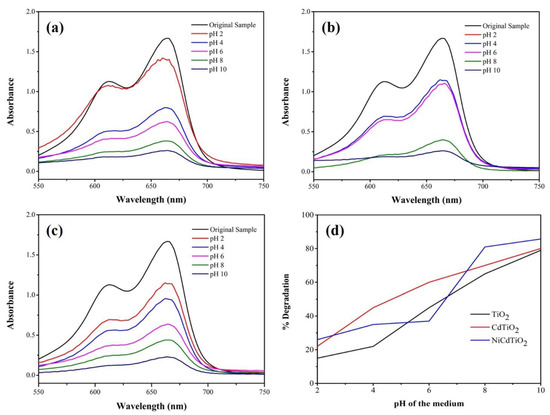
Figure 13.
UV–VIS spectra of MB dye photodegraded in different pH medium in the presence of (a) TiO2 (b) CdTiO2 (c) NiCdTiO2 (d) Comparison of %degradation of MB dye.
2.6. Photodegradation of Methyl Green (MG) Dye
2.6.1. Effect of Irradiation Time
The photodegradation efficacy of the synthesized catalysts was also investigated against methyl green (MG) dye in aqueous solutions in the presence of UV light. Figure 14a–c demonstrates the UV–VIS spectra of MG dye before reaction and after different UV light irradiation times in the presence of TiO2, CdTiO2 and NiCdTiO2, respectively. Figure 14d represents the %degradation of MG dye at varying irradiation times in the presence of catalysts. The graph clearly demonstrates that MG photodegradation increases effectively with increasing UV irradiation time. The %degradation results show that about 28, 45 and 59.5% of the MG dye was photodegraded by TiO2, NiTiO2 and CdNiTiO2, respectively, within 20 min. The %degradation was increased to 63.3, 88 and 97.5% by TiO2, NiTiO2 and CdNiTiO2, respectively, when irradiation time was increased to 100 min. The results clearly demonstrate that an increase in irradiation time results in an increased dye degradation due to availability of more and more time for dye adsorption followed by photodegradation.
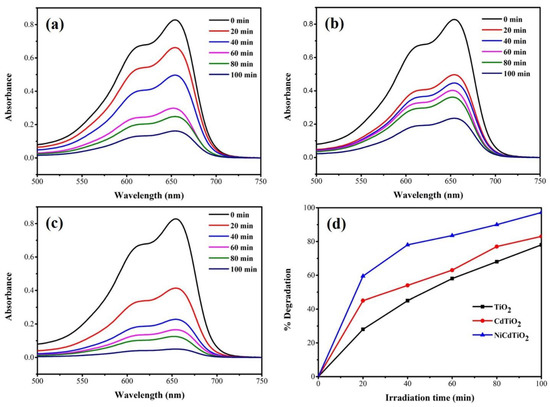
Figure 14.
UV–VIS absorption spectra of MG degraded in the presence of (a) TiO2 (b) CdTiO2 (c) NiCdTiO2 (d) Comparison of %degradation of MG dye.
2.6.2. Effect of Photocatalyst Dosage and Medium pH
The effect of catalyst dosage was evaluated by applying different dosages of photocatalysts keeping another parameters constant. Figure 15a represents the %degradation of MG dye photodegraded by different dosages of the catalysts The results show increased percent degradation of the dye with increased photocatalyst dosage. A 68, 87 and 98% degradation was achieved by 0.030 g (maximum dosage) of the TiO2, CdTiO2 and NiCdTiO2, respectively, within 30 min. The effect of pH on Mg dye degradation was also evaluated by degrading dye in different pH solutions keeping other parameters constant. Figure 15b represents the %photocatalytic degradation of MG dye in different pH media. At pH 2, the TiO2, NiTiO2 and CdNiTiO2 degraded about 12, 20 and 26% MG dye, respectively. The efficiency of MG dye degradation increases and about 67, 85 and 96.5% dye degraded at pH 10 by TiO2, NiTiO2 and CdNiTiO2, respectively, within 30 min. The increased degradation of MG dye at higher pH is due to the production of more hydroxyl radicals in the basic medium.
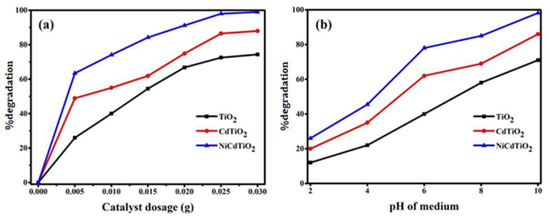
Figure 15.
%degradation of MG dye photodegradation (a) by different dosage of photocatalysts and (b) at different pH.
2.7. Photocatalytic Activity Comparison
The comparative photocatalytic efficiency of the catalysts in the photodegradation of MB and MG dyes is shown as %degradation in the Figure 16. The dyes were irradiated for 100 min in the presence of catalysts. The data shows that neat TiO2 is more efficient in degrading MB compared to MG dye. However, the nanocomposites are more effective in degrading MG dye compared to the MB dye. The ternary NiCdTiO2 has shown the highest photocatalytic efficiency and degrades about 97.5% and 86% of MG and MB dye, respectively. The present study shows supremacy over the reported results [45,46,47,48,49,50,51] due to the photodegradation capability in correlation with band gap energy as presented in Table 2.
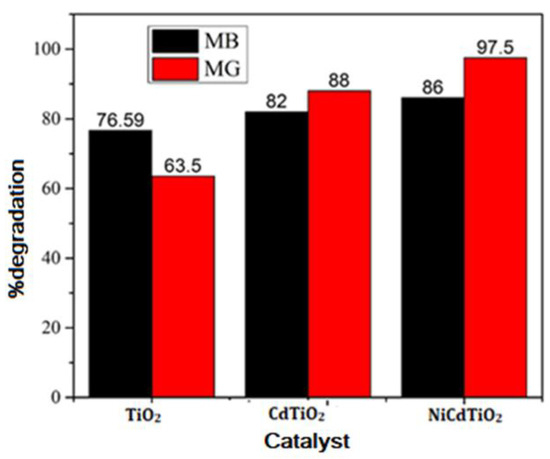
Figure 16.
Comparison of %degradation of MB and MG dyes photodegraded by all the photocatalysts.

Table 2.
Comparative analysis of the synthesized catalysts with the reported studies.
2.8. Lifespan of the Catalyst
The catalyst was regenerated from the reaction medium by simple centrifugation process and washed and dried in an oven overnight. The regenerated catalysts were utilized subsequently for five experimental runs under the optimum reaction conditions with no significant loss of activity as shown in Figure 17. The extended lifespan of the catalysts revealed the industrial scale applicability of the catalysts.
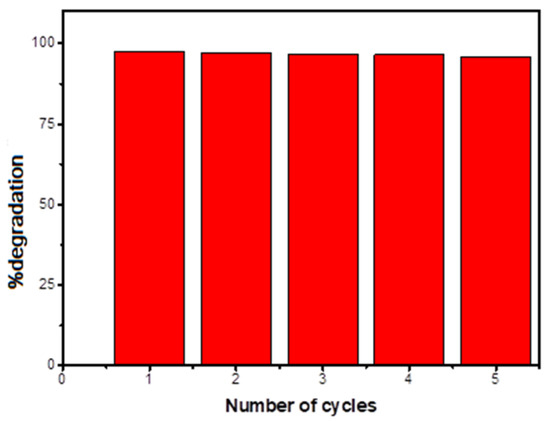
Figure 17.
Recycling of catalyst for five experimental runs.
3. Experimental Work
3.1. Materials
Titanium (IV) isopropoxide (C12H28O4Ti) (97%), cadmium (II) chloride hemi(pentahydrate) (CdCl2·2.5H2O) (98%), and nickel (II) chloride hexahydrate (NiCl2·6H2O) (98%) were purchased from Riedel-de Haen, Germany. Analytical grade sodium hydroxide (NaOH) (98%), methylene blue (98%), and methyl green (97.5%) were obtained from Sigma Aldrich, USA.
3.2. Synthesis of TiO2 Nanoparticles
The precipitation procedure was utilized for the preparation of TiO2 NPs by titanium (IV) isopropoxide precursor. A careful addition of 5 mL of titanium (IV) isopropoxide to 8 mL deionized water at 45 °C was followed by constant stirring for 1 h and resulted in white precipitate formation. The precipitates were centrifuged and washed three times with deionized water followed by methanol washings. The resultant powder was dried in an oven at 80 °C for 8 h followed by calcination at about 450 °C for 5 h.
3.3. Synthesis of Binary CdTiO2 Nanocomposites
CdTiO2 nanocomposites were synthesized via co-precipitation method. Cadmium (II) chloride hemi(pentahydrate) (0.030 mol, 6.85 g) was added to the deionized water (250 mL) and the mixture was stirred for 30 min at room temperature. The pH (9–10) of the mixture was adjusted by dropwise addition of 1 M NaOH solution. The precipitates formed during the process were centrifuged, separated and washed with deionized water followed by ethanol washing. The precipitates were dried in an oven at 80 °C for 5 h and annealed at 500 °C for 4 h. The resultant CdO NPs (0.01 M) were dispersed in methanol (5 mL) via sonication for 30 min. The dispersion was added to the TiO2 (1 M) dispersion made in 5 mL methanol. The mixture was stirred at 80 °C for 30 min and the precipitates formed were separated via centrifuge. The CdTiO2 binary nanocomposites obtained were kept overnight and oven dried at 100 °C for 2 h.
3.4. Synthesis of Ternary NiCdTiO2 Nanocomposites
Ternary NiCdTiO2 nanocomposites were prepared via co-precipitation method. Nickel (II) chloride hexahydrate (0.030 mol, 7.13 g) and cadmium (II) chloride hemi(pentahydrate) (0.030 mol, 6.85 g) were dissolved separately in deionized water (250 mL) and stirred for 30 min at ambient temperature. The pH (9–10) of the solutions were adjusted via dropwise addition of 1 M NaOH solution. The precipitates formed during the process were centrifuged and washed with deionized water followed by methanol three times. The obtained precipitates were oven dried at 80 °C for 6 h and annealed at 550 °C for 4 h. The synthesized Ni (0.001 M) and Cd (0.01 M) NPs were dispersed separately in 5 mL aqueous methanol via sonication for 30 min. The Ni and Cd dispersions were mixed with TiO2 (1 M) solution made in aqueous methanol. The mixture was sonicated continuously at 80 °C for 30 min. The precipitates were centrifuged and the product NiCdTiO2 was kept overnight and then dried at 100 °C for 5 h.
3.5. Characterization
The morphology and surface analysis were achieved through SEM (Model No. JEOL-5910; company Japan) and TEM (Tecnai F-20 FEI, USA). The elemental analysis was carried out via EDX (model INCA 200/oxford instrument, UK), while the size and phase of crystals were evaluated through XRD measurements (Model JEOL-300). The surface area and the porosity of the materials were evaluated applying a N2 adsorption instrument (Micrometrics ASAP 2020). The photocatalytic degradation of the dyes was monitored using UV-VIS spectrophotometer (UV-1800, Shimadzu, Japan).
3.6. Dyes Photodegradation
The photocatalytic activity of the prepared catalysts was evaluated for the photodegradation (PD) of methylene blue (MB) and methyl green (MG) dyes in aqueous media under UV-light. The photocatalysts were individually added to 5 mL deionized water and sonicated constantly for 30 min, followed by an addition of 10 mL dye solutions (30 ppm) to each beaker. The beakers were covered with transparent plastic sheets. The mixtures were again sonicated for 30 min, kept in the dark to attain the adsorption/desorption equilibria and then kept under UV light (UV lamp (254 nm, 15 W)) with constant stirring for specific times. The catalysts were carefully removed through centrifugation (1200 rpm, 10 min). The study was completed by evaluating the effect of irradiation time (20, 40, 60, 80 and 100 min with a 0.03 g of catalyst), photocatalyst dosage (0.010, 0.015, 0.020, 0.025 and 0.03 g at 30 min irradiation time) and medium pH (2, 4, 6, 8 and 10 with 0.03 g catalyst and 30 min irradiation time) on dyes degradation. The degradation study was followed by UV-Vis spectrophotometer and the %degradation was found by applying the equation:
where Ao and A show dye absorbance before and after UV light irradiation, respectively. While for photocatalytic degradation, a pseudo first-order kinetic model was proposed.
where C0: initial concentration, C: final concentration, kap: apparent rate constant and t: time in minutes.
4. Conclusions
In the present study, neat TiO2 nanoparticles and its binary CdTiO2 and ternary NiCdTiO2 nanocomposites were synthesized by precipitation method. The synthesis of the TiO2 and their binary and ternary nanocomposites were confirmed through various instrumental techniques. The synthesized materials have shown significant photocatalytic degradation of MB and MG dyes. The photodegradation results demonstrate that the dyes degradation increases with increasing irradiation time, catalyst dosage and pH of the medium. The increase in the degradation of the dyes with increasing photocatalyst dosage is due to more available active sites for dye adsorption followed by photodegradation. Similarly, the rapid photodegradation of the dyes at higher pH values could be a result of more reactive hydroxyl radicals formation. The coupled CdTiO2 and NiCdTiO2 nanocomposites result in the synergistic effect and have shown better photocatalytic efficiency compared to the neat TiO2 nanoparticles. The NiCdTiO2 nanocomposite is the most efficient photocatalyst for the degradation of MG (97.5% degraded in 100 min) as compared to MB (86% degraded in 100 min).
Author Contributions
Conceptualization and methodology, S.K., I.K.; Initial manuscript preparation, M.M.; Review and editing of the manuscript, M.S., A.N.; Investigation and supervision, N.M. All authors have read and agreed to the published version of the manuscript.
Funding
This research is supported by the Deanship of Scientific Research, Vice Presidency for Graduate Studies and Scientific Research, King Faisal University, Saudi Arabia (grant no. Grant2058).
Data Availability Statement
Not applicable.
Acknowledgments
The authors are grateful to Abdul Wali Khan University Mardan, for supporting the work.
Conflicts of Interest
The authors of this work have no conflict of interest to declare.
References
- Saeed, M.; Muneer, M.; ul Haq, A.; Akram, N. Photocatalysis: An effective tool for photodegradation of dyes—A review. Environ. Sci. Pollut. Res. 2022, 29, 293–311. [Google Scholar] [CrossRef] [PubMed]
- Köktürk, M.; Altindağ, F.; Ozhan, G.; Çalimli, M.H.; Nas, M.S. Textile dyes Maxilon blue 5G and Reactive blue 203 induce acute toxicity and DNA damage during embryonic development of Danio rerio. Comp. Biochem. Physiol. Part C Toxicol. Pharmacol. 2021, 242, 108947. [Google Scholar] [CrossRef] [PubMed]
- Slama, H.B.; Bouket, A.C.; Pourhassan, Z.; Alenezi, F.N.; Silini, A.; Cherif-Silini, H.; Oszako, T.; Luptakova, L.; Golińska, P.; Belbahri, L. Diversity of Synthetic Dyes from Textile Industries, Discharge Impacts and Treatment Methods. Appl. Sci. 2021, 11, 6255. [Google Scholar] [CrossRef]
- Khan, I.; Sadiq, M.; Khan, I.; Saeed, K. Manganese dioxide nanoparticles/activated carbon composite as efficient UV and visible-light photocatalyst. Environ. Sci. Pollut. Res. 2019, 26, 5140–5154. [Google Scholar] [CrossRef] [PubMed]
- Gita, S.; Shukla, S.P.; Deshmukhe, G.; Choudhury, T.G.; Saharan, N.; Singh, A.K. Toxicity Evaluation of Six Textile Dyes on Growth, Metabolism and Elemental Composition (C, H, N, S) of Microalgae Spirulina platensis: The Environmental Consequences. Bull. Environ. Contam. Toxicol. 2021, 106, 302–309. [Google Scholar] [CrossRef]
- Sharma, S.; Sharma, G.; Kumar, A.; AlGarni, T.S.; Naushad, M.; ALOthman, Z.A.; Stadler, F.J. Adsorption of cationic dyes onto carrageenan and itaconic acid-based superabsorbent hydrogel: Synthesis, characterization and isotherm analysis. J. Hazard. Mater. 2022, 421, 126729. [Google Scholar] [CrossRef]
- Abdelhamid, A.E.; El-Sayed, A.A.; Khalil, A.M. Polysulfone nanofiltration membranes enriched with functionalized graphene oxide for dye removal from wastewater. J. Polym. Eng. 2020, 40, 833–841. [Google Scholar] [CrossRef]
- Li, M.; He, Z.; Xu, J. A comparative study of ozonation on aqueous reactive dyes and reactive-dyed cotton. Color. Technol. 2021, 137, 376–388. [Google Scholar] [CrossRef]
- Mcyotto, F.; Wei, Q.; Macharia, D.K.; Huang, M.; Shen, C.; Chow, C.W.K. Effect of dye structure on color removal efficiency by coagulation. Chem. Eng. J. 2021, 405, 126674. [Google Scholar] [CrossRef]
- Srinivasan, S.; Sadasivam, S.K. Biodegradation of textile azo dyes by textile effluent non-adapted and adapted Aeromonas hydrophila. Environ. Res. 2021, 194, 110643. [Google Scholar] [CrossRef]
- Ahila, K.G.; Ravindran, B.; Muthunarayanan, V.; Nguyen, D.D.; Nguyen, X.C.; Chang, S.W.; Nguyen, V.K.; Thamaraiselvi, C. Phytoremediation Potential of Freshwater Macrophytes for Treating Dye-Containing Wastewater. Sustainability 2020, 13, 329. [Google Scholar] [CrossRef]
- Khan, I.; Zada, N.; Khan, I.; Sadiq, M.; Saeed, K. Enhancement of photocatalytic potential and recoverability of Fe3O4 nanoparticles by decorating over monoclinic zirconia. J. Environ. Health Sci. Eng. 2020, 18, 1473–1489. [Google Scholar] [CrossRef] [PubMed]
- Kurian, M. Advanced oxidation processes and nanomaterials—A review. Clean. Eng. Technol. 2021, 2, 100090. [Google Scholar] [CrossRef]
- Izghri, Z.; Enaime, G.; Eouarrat, M.; Chahid, L.; El Gaini, L.; Baçaoui, A.; Yaacoubi, A. Hydroxide Sludge/Hydrochar-Fe Composite Catalysts for Photo-Fenton Degradation of Dyes. J. Chem. 2021, 2021, 5588176. [Google Scholar] [CrossRef]
- Khan, I.; Khan, A.A.; Khan, I.; Usman, M.; Sadiq, M.; Ali, F.; Saeed, K. Investigation of the photocatalytic potential enhancement of silica monolith decorated tin oxide nanoparticles through experimental and theoretical studies. New J. Chem. 2020, 44, 13330–13343. [Google Scholar] [CrossRef]
- Khan, I.; Saeed, K.; Ali, N.; Khan, I.; Zhang, B.; Sadiq, M. Heterogeneous photodegradation of industrial dyes: An insight to different mechanisms and rate affecting parameters. J. Environ. Chem. Eng. 2020, 8, 104364. [Google Scholar] [CrossRef]
- Dodoo-Arhin, D.; Asiedu, T.; Agyei-Tuffour, B.; Nyankson, E.; Obada, D.; Mwabora, J.M. Photocatalytic degradation of Rhodamine dyes using zinc oxide nanoparticles. Mater. Today Proc. 2021, 38, 809–815. [Google Scholar] [CrossRef]
- Najjar, M.; Hosseini, H.A.; Masoudi, A.; Sabouri, Z.; Mostafapour, A.; Khatami, M.; Darroudi, M. Green chemical approach for the synthesis of SnO2 nanoparticles and its application in photocatalytic degradation of Eriochrome Black T dye. Optik 2021, 242, 167152. [Google Scholar] [CrossRef]
- Chairungsri, W.; Subkomkaew, A.; Kijjanapanich, P.; Chimupala, Y. Direct dye wastewater photocatalysis using immobilized titanium dioxide on fixed substrate. Chemosphere 2022, 286, 131762. [Google Scholar] [CrossRef]
- Lee, S.Y.; Kang, D.; Jeong, S.; Do, H.T.; Kim, J.H. Photocatalytic Degradation of Rhodamine B Dye by TiO2 and Gold Nanoparticles Supported on a Floating Porous Polydimethylsiloxane Sponge under Ultraviolet and Visible Light Irradiation. ACS Omega 2020, 5, 4233–4241. [Google Scholar] [CrossRef]
- Pang, S.; Pang, S.; Lu, Y.; Lu, Y.; Cheng, L.; Cheng, L.; Liu, J.; Liu, J.; Liu, J.; Ma, H.; et al. Facile synthesis of oxygen-deficient nano-TiO2 coordinated by acetate ligands for enhanced visible-light photocatalytic performance. Catal. Sci. Technol. 2020, 10, 3875–3889. [Google Scholar] [CrossRef]
- Padmanabhan, N.T.; Thomas, N.; Louis, J.; Mathew, D.T.; Ganguly, P.; John, H.; Pillai, S.C. Graphene coupled TiO2 photocatalysts for environmental applications: A review. Chemosphere 2021, 271, 129506. [Google Scholar] [CrossRef] [PubMed]
- Barzegar, M.H.; Sabzehmeidani, M.M.; Ghaedi, M.; Avargani, V.M.; Moradi, Z.; Roy, V.A.L.; Heidari, H. S-scheme heterojunction g-C3N4/TiO2 with enhanced photocatalytic activity for degradation of a binary mixture of cationic dyes using solar parabolic trough reactor. Chem. Eng. Res. Des. 2021, 174, 307–318. [Google Scholar] [CrossRef]
- Tian, X.; Cui, X.; Lai, T.; Ren, J.; Yang, Z.; Xiao, M.; Wang, B.; Xiao, X.; Wang, Y. Gas sensors based on TiO2 nanostructured materials for the detection of hazardous gases: A review. Nano Mater. Sci. 2021, 3, 390–403. [Google Scholar] [CrossRef]
- Heo, B.; Ha, J.; Kim, Y.T.; Choi, J. 10 μm-thick MoO3-coated TiO2 nanotubes as a volume expansion regulated binder-free anode for lithium ion batteries. J. Ind. Eng. Chem. 2021, 96, 364–370. [Google Scholar] [CrossRef]
- Kumar, R.; Kumar, R.; Singh, B.K.; Soam, A.; Parida, S.; Sahajwalla, V.; Bhargava, P. In situ carbon-supported titanium dioxide (ICS-TiO2) as an electrode material for high performance supercapacitors. Nanoscale Adv. 2020, 2, 2376–2386. [Google Scholar] [CrossRef]
- Ziaeifar, F.; Alizadeh, A.; Shariatinia, Z. Dye sensitized solar cells fabricated based on nanocomposite photoanodes of TiO2 and AlMo0.5O3 perovskite nanoparticles. Sol. Energy 2021, 218, 435–444. [Google Scholar] [CrossRef]
- Kwon, S.H.; Kim, T.H.; Kim, S.M.; Oh, S.; Kim, K.K. Ultraviolet light-emitting diode-assisted highly sensitive room temperature NO2 gas sensors based on low-temperature solution-processed ZnO/TiO2 nanorods decorated with plasmonic Au nanoparticles. Nanoscale 2021, 13, 12177–12184. [Google Scholar] [CrossRef]
- Badvi, K.; Javanbakht, V. Enhanced photocatalytic degradation of dye contaminants with TiO2 immobilized on ZSM-5 zeolite modified with nickel nanoparticles. J. Clean. Prod. 2021, 280, 124518. [Google Scholar] [CrossRef]
- Veziroglu, S.; Obermann, A.L.; Ullrich, M.; Hussain, M.; Kamp, M.; Kienle, L.; Leißner, T.; Rubahn, H.G.; Polonskyi, O.; Strunskus, T.; et al. Photodeposition of Au Nanoclusters for Enhanced Photocatalytic Dye Degradation over TiO2 Thin Film. ACS Appl. Mater. Interfaces 2020, 12, 14983–14992. [Google Scholar] [CrossRef]
- Bellè, U.; Pelizzari, F.; Lucotti, A.; Castiglioni, C.; Ormellese, M.; Pedeferri, M.; Diamanti, M.V. Immobilized Nano-TiO2 Photocatalysts for the Degradation of Three Organic Dyes in Single and Multi-Dye Solutions. Coatings 2020, 10, 919. [Google Scholar] [CrossRef]
- Zada, N.; Saeed, K.; Khan, I. Decolorization of Rhodamine B dye by using multiwalled carbon nanotubes/Co–Ti oxides nanocomposite and Co–Ti oxides as photocatalysts. Appl. Water Sci. 2020, 10, 40. [Google Scholar] [CrossRef]
- Khlyustova, A.; Sirotkin, N.; Kusova, T.; Kraev, A.; Titov, V.; Agafonov, A. Doped TiO2: The effect of doping elements on photocatalytic activity. Mater. Adv. 2020, 1, 1193–1201. [Google Scholar] [CrossRef]
- Samuel, J.J.; Yam, F.K. Photocatalytic degradation of methylene blue under visible light by dye sensitized titania. Mater. Res. Express 2020, 7, 015051. [Google Scholar] [CrossRef]
- Pino, E.; Calderón, C.; Herrera, F.; Cifuentes, G.; Arteaga, G. Photocatalytic Degradation of Aqueous Rhodamine 6G Using Supported TiO2 Catalysts. A Model for the Removal of Organic Contaminants From Aqueous Samples. Front. Chem. 2020, 8, 365. [Google Scholar] [CrossRef]
- Habibi-Yangjeh, A.; Feizpoor, S.; Seifzadeh, D.; Ghosh, S. Improving visible-light-induced photocatalytic ability of TiO2 through coupling with Bi3O4Cl and carbon dot nanoparticles. Sep. Purif. Technol. 2020, 238, 116404. [Google Scholar] [CrossRef]
- Rani, M.; Keshu; Shanker, U. Efficient degradation of organic pollutants by novel titanium dioxide coupled bismuth oxide nanocomposite: Green synthesis, kinetics and photoactivity. J. Environ. Manag. 2021, 300, 113777. [Google Scholar] [CrossRef]
- Nyankson, E.; Efavi, J.K.; Agyei-Tuffour, B.; Manu, G. Synthesis of TiO2-Ag3PO4 photocatalyst material with high adsorption capacity and photocatalytic activity: Application in the removal of dyes and pesticides. RSC Adv. 2021, 11, 17032–17045. [Google Scholar] [CrossRef]
- Chakhtouna, H.; Benzeid, H.; Zari, N.; Qaiss, A.e.k.; Bouhfid, R. Recent progress on Ag/TiO2 photocatalysts: Photocatalytic and bactericidal behaviors. Environ. Sci. Pollut. Res. 2021, 28, 44638–44666. [Google Scholar] [CrossRef]
- Radoor, S.; Karayil, J.; Jayakumar, A.; Parameswaranpillai, J.; Siengchin, S. Release of toxic methylene blue from water by mesoporous silicalite-1: Characterization, kinetics and isotherm studies. Appl. Water Sci. 2021, 11, 110. [Google Scholar] [CrossRef]
- Sun, Z.; Feng, T.; Zhou, Z.; Wu, H. Removal of methylene blue in water by electrospun PAN/β-CD nanofibre membrane. E-Polymers 2021, 21, 398–410. [Google Scholar] [CrossRef]
- Khan, I.; Saeed, K.; Zekker, I.; Zhang, B.; Hendi, A.H.; Ahmad, A.; Ahmad, S.; Zada, N.; Ahmad, H.; Shah, L.A.; et al. Review on Methylene Blue: Its Properties, Uses, Toxicity and Photodegradation. Water 2022, 14, 242. [Google Scholar] [CrossRef]
- Sultana, S.; Rafiuddin; Khan, M.Z.; Umar, K.; Ahmed, A.S.; Shahadat, M. SnO2–SrO based nanocomposites and their photocatalytic activity for the treatment of organic pollutants. J. Mol. Struct. 2015, 1098, 393–399. [Google Scholar] [CrossRef]
- Haque, M.M.; Khan, A.; Umar, K.; Mir, N.A.; Muneer, M.; Harada, T.; Matsumura, M. Synthesis, Characterization and Photocatalytic Activity of Visible Light Induced Ni-Doped TiO2. Energy Environ. Focus 2013, 2, 73–78. [Google Scholar] [CrossRef]
- Shaban, M.; Ahmed, A.M.; Shehata, N.; Betiha, M.A.; Rabie, A.M. Ni-doped and Ni/Cr co-doped TiO2 nanotubes for enhancement of photocatalytic degradation of methylene blue. J. Colloid Interface Sci. 2019, 555, 31–41. [Google Scholar] [CrossRef]
- Zhang, W.; Li, X.; Jia, G.; Gao, Y.; Wang, H.; Cao, Z.; Liu, J. Preparation, characterization, and photocatalytic activity of boron and lanthanum co-doped TiO2. Catal. Commun. 2014, 45, 144–147. [Google Scholar] [CrossRef]
- Kader, S.; Al-Mamun, M.R.; Suhan, M.B.K.; Shuchi, S.B.; Islam, M.S. Enhanced photodegradation of methyl orange dye under UV irradiation using MoO3 and Ag doped TiO2 photocatalysts. Environ. Technol. Innov. 2022, 27, 102476. [Google Scholar] [CrossRef]
- Zhu, X.; Pei, L.; Zhu, R.; Jiao, Y.; Tang, R.; Feng, W. Preparation and characterization of Sn/La co-doped TiO2 nanomaterials and their phase transformation and photocatalytic activity. Sci. Rep. 2018, 8, 12387. [Google Scholar] [CrossRef]
- Stoyanova, A.; Ivanova, N.; Bachvarova-Nedelcheva, A.; Christov, C. Synthesis and photocatalytic activity of cerium-doped and cerium-boron co-doped TiO2 nanoparticles. J. Chem. Technol. Metall. 2021, 56, 1294–1302. [Google Scholar]
- Qutub, N.; Singh, P.; Sabir, S.; Sagadevan, S.; Oh, W.C. Enhanced photocatalytic degradation of Acid Blue dye using CdS/TiO2 nanocomposite. Sci. Rep. 2022, 12, 5759. [Google Scholar] [CrossRef]
- Ganesh, I.; Gupta, A.K.; Kumar, P.P.; Sekhar, P.S.C.; Radha, K.; Padmanabham, G.; Sundararajan, G. Preparation and Characterization of Ni-Doped TiO2 Materials for photocurrent and photocatalytic applications. Sci. World J. 2012, 2012, 127326. [Google Scholar] [CrossRef] [PubMed]
Disclaimer/Publisher’s Note: The statements, opinions and data contained in all publications are solely those of the individual author(s) and contributor(s) and not of MDPI and/or the editor(s). MDPI and/or the editor(s) disclaim responsibility for any injury to people or property resulting from any ideas, methods, instructions or products referred to in the content. |
© 2022 by the authors. Licensee MDPI, Basel, Switzerland. This article is an open access article distributed under the terms and conditions of the Creative Commons Attribution (CC BY) license (https://creativecommons.org/licenses/by/4.0/).